
- #Visual studio extensions debugging console full#
- #Visual studio extensions debugging console code#
- #Visual studio extensions debugging console windows#
Observe that the value of the name variable is "", or String.Empty.Ĭonfirm the value is an empty string by entering the following statement in the Immediate window and pressing Enter. In this case, Main is the currently executing method. Select the Locals window, which shows the values of variables that are local to the currently executing method. In the console window, press the Enter key when prompted to enter your name.īecause the condition you specified ( name is either null or String.Empty) has been satisfied, program execution stops when it reaches the breakpoint and before the Console.WriteLine method executes. Start the program with debugging by pressing F5. Another option is to specify a filter condition, which interrupts program execution based on such attributes as a thread identifier, process name, or thread name. Instead of a conditional expression, you can specify a hit count, which interrupts program execution before a statement is executed a specified number of times. String.IsNullOrEmpty(name)Įach time the breakpoint is hit, the debugger calls the String.IsNullOrEmpty(name) method, and it breaks on this line only if the method call returns true.
#Visual studio extensions debugging console code#
Select the box for Conditions if it's not already selected.įor the Conditional Expression, enter the following code in the field that shows example code that tests if x is 5.

In the context menu, select Conditions to open the Breakpoint Settings dialog. Right-click on the red dot that represents the breakpoint. What happens if the user doesn't enter anything? You can test this with a useful debugging feature called a conditional breakpoint. The program displays the string that the user enters. Press any key to exit the application and stop debugging. The values displayed in the console window correspond to the changes you made in the Immediate window. Another way to continue is by choosing Debug > Continue from the menu. In addition, the values of the variables are updated in the Locals window. The Immediate window displays the value of the string variable and the properties of the DateTime value.
#Visual studio extensions debugging console windows#
If the Immediate window is not visible, display it by choosing Debug > Windows > Immediate.Įnter name = "Gracie" in the Immediate window and press the Enter key.Įnter currentDate = DateTime.Parse("").ToUniversalTime() in the Immediate window and press the Enter key. You can interactively change the value of variables to see how it affects your program. The Immediate window lets you interact with the application you're debugging. The Locals window displays the values of variables that are defined in the currently executing method. Program execution stops when it reaches the breakpoint and before the Console.WriteLine method executes. Another way to start debugging is by choosing Debug > Start Debugging from the menu.Įnter a string in the console window when the program prompts for a name, and then press Enter. Press F5 to run the program in Debug mode. Other ways to set a breakpoint are by placing the cursor in the line of code and then pressing F9 or choosing Debug > Toggle Breakpoint from the menu bar.Īs the following image shows, Visual Studio indicates the line on which the breakpoint is set by highlighting it and displaying a red dot in the left margin. The left margin is to the left of the line numbers. Set a breakpoint on the line that displays the name, date, and time, by clicking in the left margin of the code window on that line. The following toolbar image shows that Visual Studio is configured to compile the Debug version of the app:Ī breakpoint temporarily interrupts the execution of the application before the line with the breakpoint is executed. The current build configuration is shown on the toolbar. NET console application using Visual Studio. Open the project that you created in Create a. The release configuration of a program has no symbolic debug information and is fully optimized.īy default, Visual Studio uses the Debug build configuration, so you don't need to change it before debugging. Optimization complicates debugging, because the relationship between source code and generated instructions is more complex.
#Visual studio extensions debugging console full#
In the Debug configuration, a program compiles with full symbolic debug information and no optimization.

You use the Debug build configuration for debugging and the Release configuration for the final release distribution. NET console application using Visual Studio.ĭebug and Release are Visual Studio's built-in build configurations. This tutorial works with the console app that you create in Create a.This tutorial introduces the debugging tools available in Visual Studio.


 0 kommentar(er)
0 kommentar(er)
